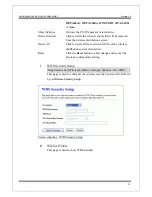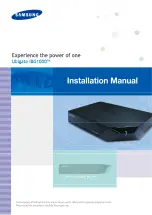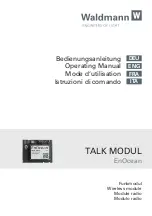
USER’S MANUAL OF WLAN ACCESS POINT
Version: 1.1
authentication server, typically one that supports RADIUS and the selected EAP
authentication protocol, will be added to the network.
4.16
What is WPA2?
It is the second generation of WPA. WPA2 is based on the final IEEE 802.11i
amendment to the 802.11 standard.
4.17
What is 802.1x Authentication?
802.1x is a framework for authenticated MAC-level access control, defines Extensible
Authentication Protocol (EAP) over LANs (WAPOL). The standard encapsulates and
leverages much of EAP, which was defined for dial-up authentication with
Point-to-Point Protocol in RFC 2284.
Beyond encapsulating EAP packets, the 802.1x standard also defines EAPOL messages
that convey the shared key information critical for wireless security.
4.18
What is Temporal Key Integrity Protocol (TKIP)?
The Temporal Key Integrity Protocol, pronounced tee-kip, is part of the IEEE 802.11i
encryption standard for wireless LANs. TKIP is the next generation of WEP, the Wired
Equivalency Protocol, which is used to secure 802.11 wireless LANs. TKIP provides
per-packet key mixing, a message integrity check and a re-keying mechanism, thus
fixing the flaws of WEP.
4.19
What is Advanced Encryption Standard (AES)?
Security issues are a major concern for wireless LANs, AES is the U.S. government’s
next-generation cryptography algorithm, which will replace DES and 3DES.
35
4.20
What is Inter-Access Point Protocol (IAPP)?
The IEEE 802.11f Inter-Access Point Protocol (IAPP) supports Access Point Vendor
interoperability, enabling roaming of 802.11 Stations within IP subnet.
IAPP defines messages and data to be exchanged between Access Points and between
the IAPP and high layer management entities to support roaming. The IAPP protocol
uses TCP for inter-Access Point communication and UDP for RADIUS request/response
exchanges. It also uses Layer 2 frames to update the forwarding tables of Layer 2
devices.


































